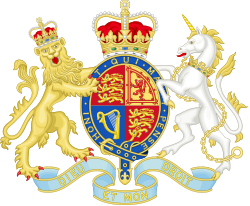Francis Osborne, 5. Duke of Leeds

Francis Godolphin Osborne, 5. Duke of Leeds (* 29. Januar 1751; † 31. Januar 1799) war ein britischer Aristokrat (Peer) und Politiker.
Leben

Francis Osborne war der Sohn von Thomas Osborne, 4. Duke of Leeds und Mary Godolphin, einer Tochter von Francis Godolphin, 2. Earl of Godolphin. Als Titelerbe führte er den Höflichkeitstitel Marquess of Carmarthen.
Osborne wurde an der Westminster School und an dem Christ Church College an der University of Oxford ausgebildet. Von 1774 bis 1775 war er Abgeordneter im House of Commons. 1776 wurde er als 5. Baron Osborne durch Writ of Acceleration in das House of Lords berufen. 1777 wurde er unter König George III. zum Lord Chamberlain of the Household der Königin ernannt, der aus Deutschland stammenden Sophie Charlotte von Mecklenburg-Strelitz.
Im House of Lords (Oberhaus) war er ein entschlossener Gegner des Premierministers Lord North, der ihn 1780 um seine Positionen als Lord Chamberlain und als Lord Lieutenant des East Riding of Yorkshire brachte. Er gewann letztere jedoch zwei Jahre später wieder zurück.
1783 wurde Osborne als Botschafter in Frankreich vorgeschlagen, er lehnte diesen Posten aber ab und übernahm in der Regierung von William Pitt den 1782 neu geschaffenen Posten eines Secretary of State for Foreign Affairs, was der Position eines Außenministers entsprach.[1] 1789 wurde er nach dem Tod seines Vaters Thomas Osborne der Duke of Leeds und führte als Leader of the House of Lords von 1789 bis 1790 das Oberhaus an.
Nach seinem Ausscheiden aus dem Foreign Office (Auswärtiges Amt) 1791 nahm er nur mehr wenig an der Politik teil. Er starb 1799 in London im Alter von 48 Jahren. Seine erste Frau war Amelia (1754–1784), Tochter von Robert Darcy, 4. Earl of Holderness, und ab 1778 Baroness Conyers. Sein ältester Sohn George William Frederick Osborne folgte ihm als Duke of Leeds und seiner Mutter als Baron Conyers.
Literatur
- Francis Godolphin Osborne: The Political Memoranda of Francis Fifth Duke of Leeds, BiblioBazaar 2009, ISBN 978-1-103-10812-1
Einzelnachweise
- ↑ Powicke & Fryde: Handbook of British Chronology. Second Edition, London, 1961, S. 116
Weblinks
- Francis Godolphin Osborne, 5th Duke of Leeds auf thepeerage.com, abgerufen am 13. August 2015.
| Vorgänger | Amt | Nachfolger |
|---|---|---|
| Thomas Osborne | Duke of Leeds 1789–1799 | George Osborne |
| Personendaten | |
|---|---|
| NAME | Osborne, Francis, 5. Duke of Leeds |
| ALTERNATIVNAMEN | Leeds, Francis Godolphin Osborne 5. Duke of (vollständiger Name) |
| KURZBESCHREIBUNG | britischer Politiker |
| GEBURTSDATUM | 29. Januar 1751 |
| STERBEDATUM | 31. Januar 1799 |
| STERBEORT | London |
Auf dieser Seite verwendete Medien
Francis Osborne, 5th Duke of Leeds, by Benjamin West (died 1820), given to the National Portrait Gallery, London in 1888. See source website for additional information.
This set of images was gathered by User:Dcoetzee from the National Portrait Gallery, London website using a special tool. All images in this batch have been confirmed as author died before 1939 according to the official death date listed by the NPG.Autor/Urheber: Sodacan, Lizenz: CC BY-SA 3.0
Royal Coat of Arms of the United Kingdom of Great Britain and Northern Ireland in the style used by the Government of Queen Elizabeth II from 1952 to 2022 (as used in all places except Scotland).
| “ | Quarterly, First and Fourth Gules three lions passant guardant in pale Or armed and langued Azure (for England), Second quarter Or a lion rampant within a double tressure flory counter-flory Gules (for Scotland), Third quarter Azure a harp Or stringed Argent (for Ireland), the whole surrounded by the Garter; for a Crest, the imperial crown Proper; for Supporters, dexter a lion rampant guardant Or crowned as the Crest, sinister a unicorn Argent armed, crined and unguled Proper, gorged with a coronet Or composed of crosses patée and fleurs de lys a chain affixed thereto passing between the forelegs and reflexed over the back also Or; Motto 'Dieu et mon Droit’ ('God and my Right') below the shield. | ” |
- PINCHES, J.H & R.V., The Royal Heraldry of England, 1974, Heraldry Today.


